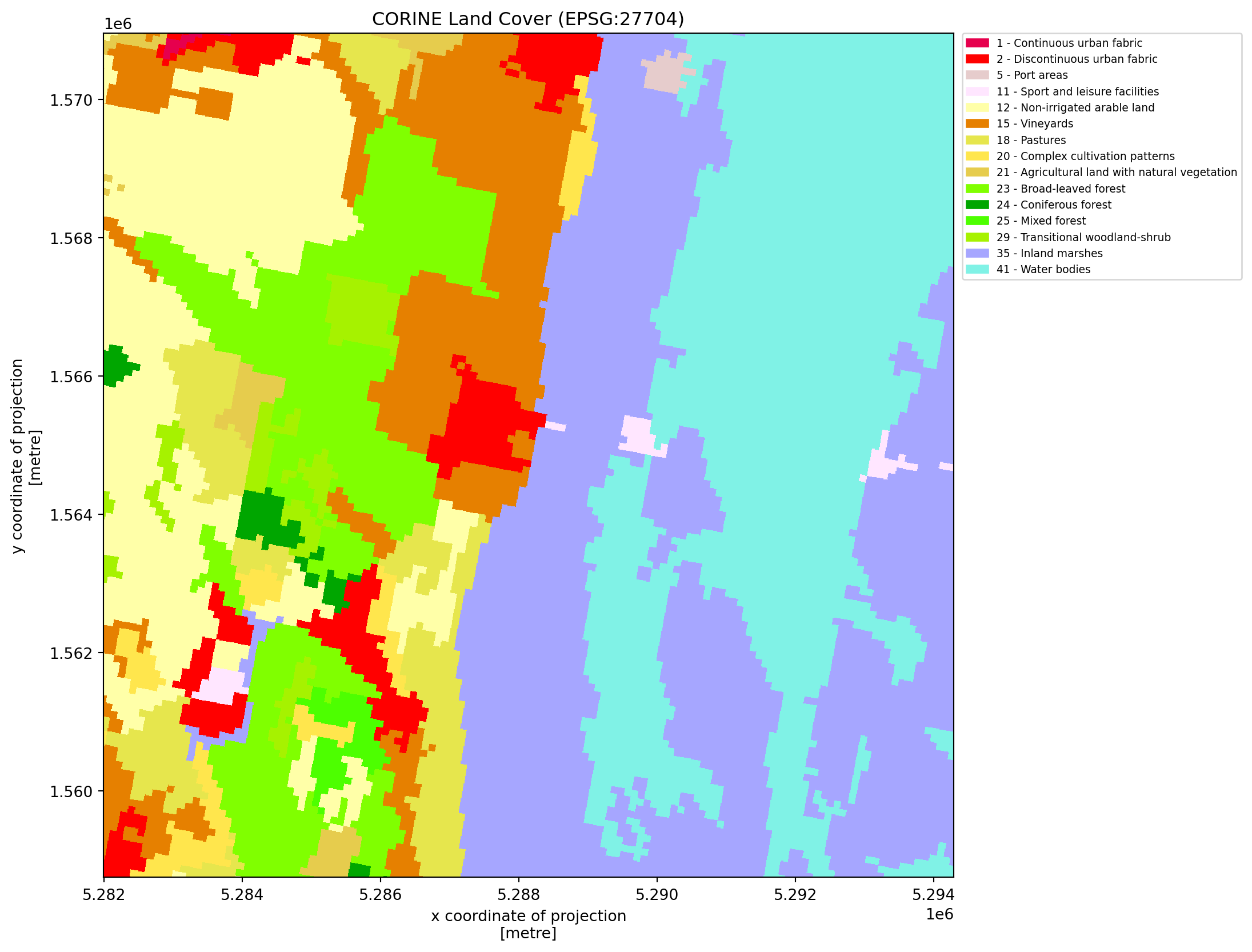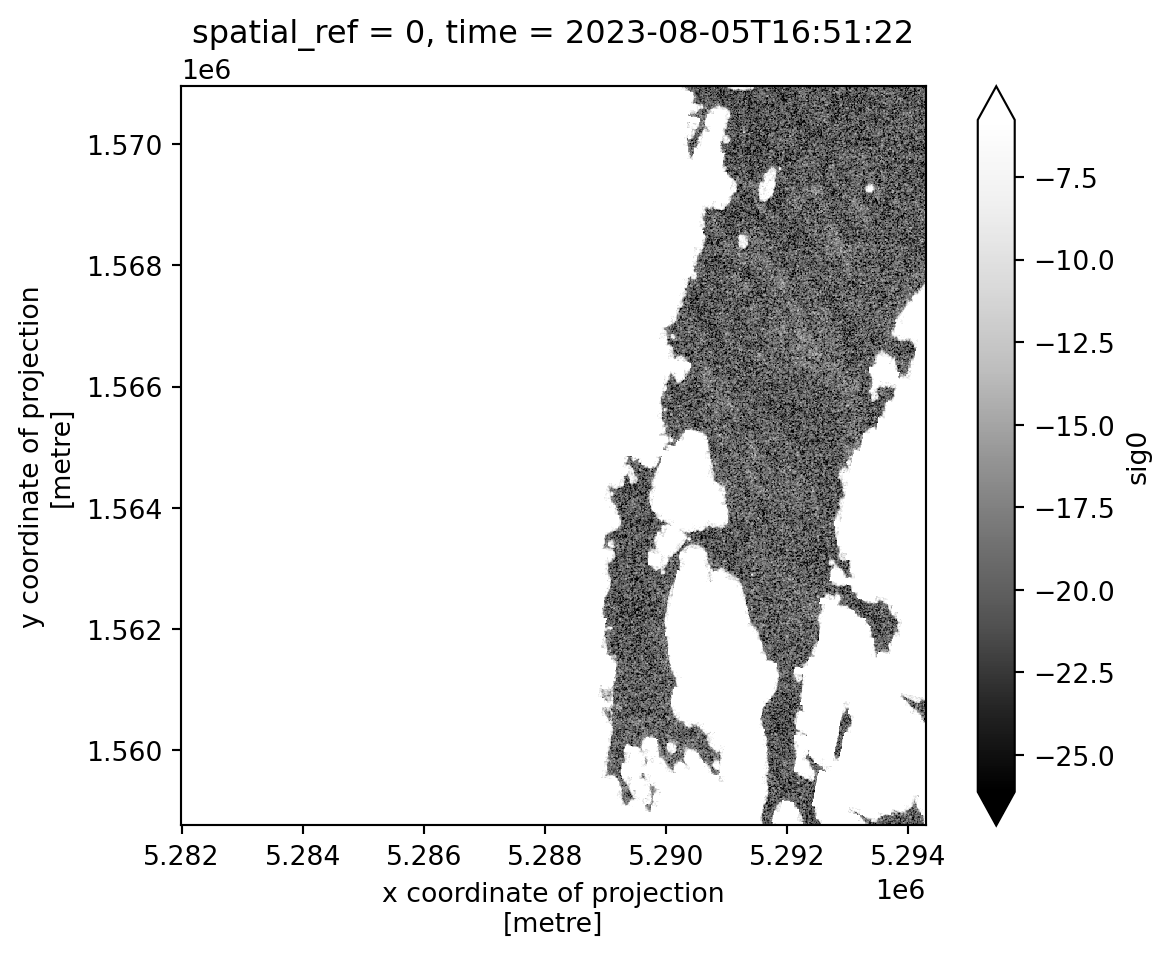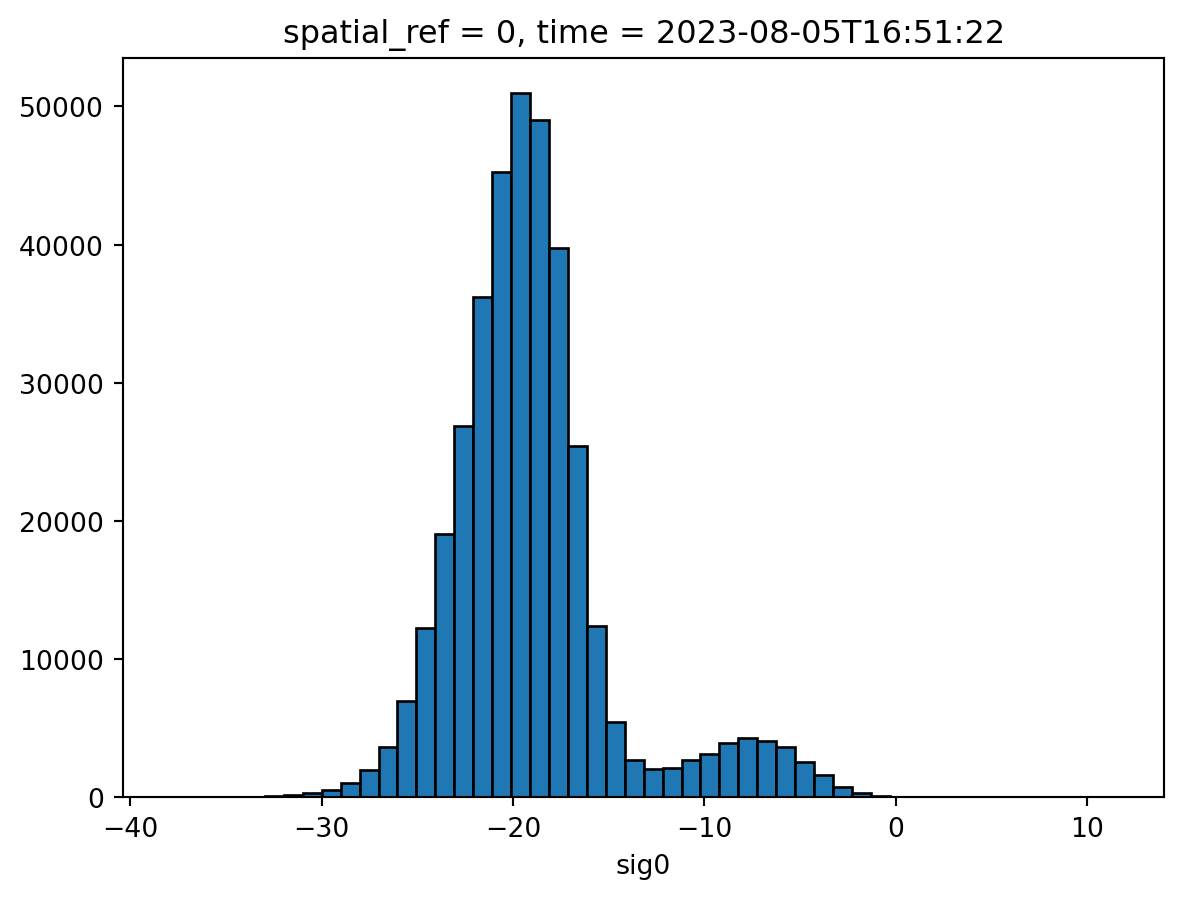import numpy as np
import xarray as xr
import rioxarray # noqa: F401
import intake
import json
import matplotlib.pyplot as plt
import matplotlib.patches as mpatches
from matplotlib.colors import ListedColormap, BoundaryNorm
import holoviews as hv
from holoviews.streams import RangeXY
hv.extension("bokeh")In this notebook, we will investigate the varying backscatter values associated with different land surfaces like water bodies, forests, grasslands and urban areas. We will use backscatter data from the Sentinel-1 satellite and we will utilize the CORINE Land Cover dataset to classify and extrapolate these surfaces, enabling us to analyze how different land cover types influence backscatter responses.
6.1 Load Sentinel-1 Data
For our analysis we are using sigma naught backscatering data from Sentinel-1. The images we are analyzing cover the region south of Vienna and west of Lake Neusiedl. We load the data and and apply again a preprocessing function. Here we extract the scaling factor and the date the image was taken from the metadata. We will focus our attention to a smaller area containing a part of the Lake Neusiedl Lake and its surrounding land. The obtainedxarray dataset and is then converted to an array, because we only have one variable, the VV backscatter values.
url = "https://huggingface.co/datasets/martinschobben/microwave-remote-sensing/resolve/main/microwave-remote-sensing.yml"
cat = intake.open_catalog(url)
sig0_da = cat.neusiedler.read().sig0.compute()Let’s have a look at the data by plotting the first timeslice.
sig0_da.isel(time=0).plot(robust=True, cmap="Greys_r").axes.set_aspect("equal")
6.2 Load CORINE Landcover Data
We will load the CORINE Land Cover, which is a pan-European land cover and land use inventory with 44 thematic classes. The resolution of this classification is 100 by 100m and the file was created in 2018 (CORINE Land Cover).
cor_da = cat.corine.read().land_cover.compute()6.2.1 Colormapping and Encoding
For the different land cover types we use the official color encoding.
# Load encoding
with cat.corine_cmap.read()[0] as f:
color_mapping_data = json.load(f)
# Get mapping
color_mapping = {item["value"]: item for item in
color_mapping_data["land_cover"]}
# Create cmap and norm for plotting
colors = [info["color"] for info in color_mapping.values()]
categories = [info["value"] for info in color_mapping.values()]
cmap = ListedColormap(colors)
norm = BoundaryNorm(categories + [max(categories) + 1], len(categories))Now we can plot the CORINE Land Cover dataset.
# Get landcover codes present in the image
present_landcover_codes = np.unique(cor_da.values[~np.isnan(cor_da.values)].
astype(int))
# Get colors + text for legend
handles = [
mpatches.Patch(
color=info["color"], label=(f'{info["value"]} - ' + (info["label"]))
)
for info in color_mapping.values()
if info["value"] in present_landcover_codes
]
# Create the plot
cor_da.plot(figsize=(10, 10), cmap=cmap, norm=norm, add_colorbar=False).\
axes.set_aspect("equal")
plt.legend(
handles=handles,
bbox_to_anchor=(1.01, 1),
loc="upper left",
borderaxespad=0,
fontsize=7,
)
plt.title("CORINE Land Cover (EPSG:27704)")Text(0.5, 1.0, 'CORINE Land Cover (EPSG:27704)')
Now we are ready to merge the backscatter data (sig0_da) with the land cover dataset (cor_da) to have one dataset combining all data.
var_ds = xr.merge([sig0_da, cor_da]).drop_vars("band")
var_ds<xarray.Dataset> Size: 108MB
Dimensions: (time: 8, x: 1230, y: 1221)
Coordinates:
spatial_ref int64 8B 0
* time (time) datetime64[ns] 64B 2023-08-05T16:51:22 ... 2023-10-28...
* x (x) float64 10kB 5.282e+06 5.282e+06 ... 5.294e+06 5.294e+06
* y (y) float64 10kB 1.571e+06 1.571e+06 ... 1.559e+06 1.559e+06
Data variables:
sig0 (time, y, x) float64 96MB -6.99 -7.32 -8.78 ... -14.32 -14.22
land_cover (y, x) float64 12MB 12.0 12.0 12.0 12.0 ... 41.0 41.0 41.0 41.06.3 Backscatter Variability
With this combined dataset we can study backscatter variability in relation to natural media. For example we can look at the backscatter variability for water by clipping the dataset to only contain the land cover class water, like so:
# 41 = encoded value for water bodies
waterbodies_mask = var_ds.land_cover == 41
waterbodies_mask.plot().axes.set_aspect("equal")
This gives use backscatter values over water only.
waterbodies_sig0 = var_ds.sig0.isel(time=0).where(waterbodies_mask)
waterbodies_sig0.plot(robust=True, cmap="Greys_r").axes.set_aspect("equal")
To get an idea of the variability we can create a histogram. Radar backscatter from water bodies fluctuates with surface roughness, which changes with wind conditions, creating spatial and temporal variations in signal intensity.
waterbodies_sig0.plot.hist(bins=50, edgecolor="black")(array([5.0000e+00, 5.0000e+00, 8.0000e+00, 1.4000e+01, 3.5000e+01,
7.8000e+01, 1.5600e+02, 3.0500e+02, 5.4000e+02, 1.0380e+03,
1.9550e+03, 3.6850e+03, 6.9910e+03, 1.2269e+04, 1.9088e+04,
2.6859e+04, 3.6217e+04, 4.5276e+04, 5.0939e+04, 4.9020e+04,
3.9729e+04, 2.5400e+04, 1.2426e+04, 5.4390e+03, 2.6990e+03,
2.0500e+03, 2.1330e+03, 2.6890e+03, 3.1490e+03, 3.9510e+03,
4.2970e+03, 4.1110e+03, 3.6350e+03, 2.5900e+03, 1.6020e+03,
7.5000e+02, 3.5200e+02, 1.2300e+02, 5.6000e+01, 3.7000e+01,
2.8000e+01, 2.1000e+01, 1.3000e+01, 9.0000e+00, 1.0000e+01,
8.0000e+00, 1.0000e+01, 5.0000e+00, 6.0000e+00, 4.0000e+00]),
array([-37.91 , -36.9202, -35.9304, -34.9406, -33.9508, -32.961 ,
-31.9712, -30.9814, -29.9916, -29.0018, -28.012 , -27.0222,
-26.0324, -25.0426, -24.0528, -23.063 , -22.0732, -21.0834,
-20.0936, -19.1038, -18.114 , -17.1242, -16.1344, -15.1446,
-14.1548, -13.165 , -12.1752, -11.1854, -10.1956, -9.2058,
-8.216 , -7.2262, -6.2364, -5.2466, -4.2568, -3.267 ,
-2.2772, -1.2874, -0.2976, 0.6922, 1.682 , 2.6718,
3.6616, 4.6514, 5.6412, 6.631 , 7.6208, 8.6106,
9.6004, 10.5902, 11.58 ]),
<BarContainer object of 50 artists>)
6.4 Variability over Time
Next we will look at the changes in variability in backscatter values over time for each of the CORINE Land Cover types. We do this by creating the following interactive plot. We can spot that backscatter in agricultural fields varies due to seasonal cycles like planting, growing, and harvesting, each of which changes vegetation structure. Changes in backscatter are strongly related to soil moisture content from irrigation or rainfall. Ultimately, phenological stages of crops and canopy moisture dynamics can affect the backscatter signal.
robust_min = var_ds.sig0.quantile(0.02).item()
robust_max = var_ds.sig0.quantile(0.98).item()
bin_edges = [
i + j * 0.5
for i in range(int(robust_min) - 2, int(robust_max) + 2)
for j in range(2)
]
land_cover = {"\xa0\xa0\xa0 Complete Land Cover": 1}
land_cover.update(
{
f"{int(value): 02} {color_mapping[value]['label']}": int(value)
for value in present_landcover_codes
}
)
time = var_ds.sig0["time"].values
rangexy = RangeXY()
def load_image(time, land_cover, x_range, y_range):
"""
Callback Function Landcover.
Parameters
----------
time: panda.datatime
time slice
landcover: int
land cover type
x_range: array_like
longitude range
y_range: array_like
latitude range
Returns
-------
holoviews.Image
"""
if land_cover == "\xa0\xa0\xa0 Complete Land Cover":
sig0_selected_ds = var_ds.sig0.sel(time=time)
else:
land_cover_value = int(land_cover.split()[0])
mask_ds = var_ds.land_cover == land_cover_value
sig0_selected_ds = var_ds.sig0.sel(time=time).where(mask_ds)
hv_ds = hv.Dataset(sig0_selected_ds)
img = hv_ds.to(hv.Image, ["x", "y"])
if x_range and y_range:
img = img.select(x=x_range, y=y_range)
return hv.Image(img)
dmap = (
hv.DynamicMap(load_image, kdims=["Time", "Landcover"], streams=[rangexy])
.redim.values(Time=time, Landcover=land_cover)
.hist(normed=True, bins=bin_edges)
)
image_opts = hv.opts.Image(
cmap="Greys_r",
colorbar=True,
tools=["hover"],
clim=(robust_min, robust_max),
aspect="equal",
framewise=False,
frame_height=500,
frame_width=500,
)
hist_opts = hv.opts.Histogram(width=350, height=555)
dmap.opts(image_opts, hist_opts)